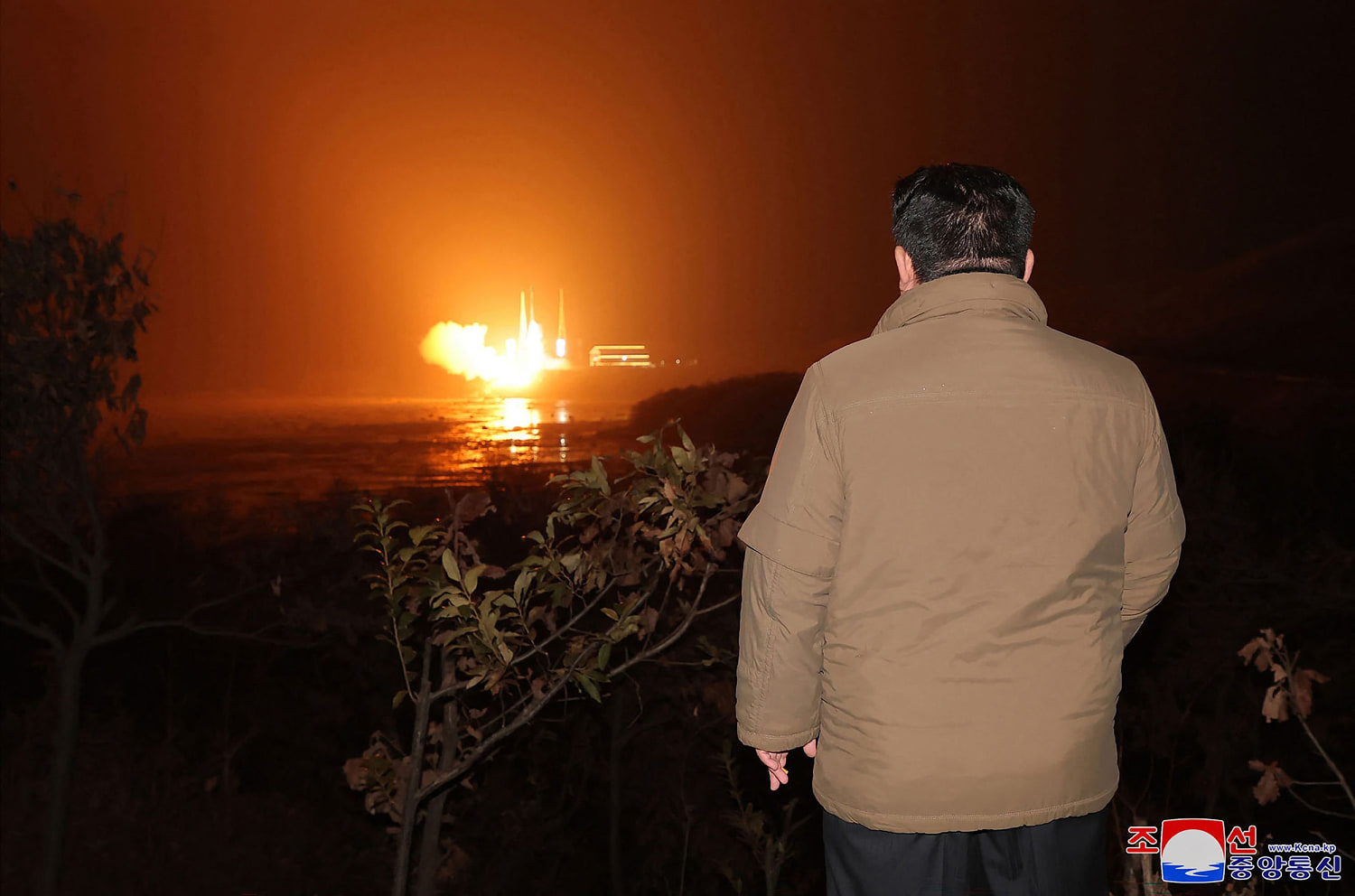[ad_1]

SEOUL, South Korea — South Korea moved Wednesday to suspend parts of a 2018 military pact with North Korea after the North defied warnings from the U.S. and its allies with what it said was the successful launch of its first spy satellite.
North Korea launched the Malligyong-1 satellite on a Chollima-1 rocket from the Sohae facility on its west coast at 10:42 p.m. Tuesday (8:42 a.m. ET), according to KCNA, the state news agency. The rocket flew normally along the preset flight track, and the satellite entered orbit at 10:54 p.m., KCNA said, citing North Korea’s space agency.
Photographs published by state media appeared to show North Korean leader Kim Jong Un overseeing the launch, which was earlier reported by South Korea and Japan and the success of which could not immediately be independently verified.
The Japanese government’s top spokesperson, Chief Cabinet Secretary Hirokazu Matsuno, said Wednesday that no satellites had been confirmed to have entered Earth’s orbit and that the Defense Ministry was still analyzing details. U.S. Defense Department spokesperson Sabrina Singh said the U.S. was still assessing whether the launch had been successful.
North Korea had notified Japan that it would launch the satellite, its third attempt this year after two earlier failures, between Wednesday and Dec. 1.
Pyongyang has said it has a “sovereign right” to develop spy satellites and other technologies to defend itself against what it sees as military aggression by the U.S. and its allies, and it vowed Wednesday to launch more satellites in the near future.
The U.S., South Korea and Japan strongly condemned North Korea’s latest launch, which used ballistic missile technology in violation of United Nations Security Council resolutions. National Security Council spokesperson Adrienne Watson said it raised tensions and “risks destabilizing the security situation in the region and beyond.”
South Korea responded to the launch by suspending parts of a 2018 agreement aimed at reducing tensions between the two Koreas, said a spokesperson for President Yoon Suk Yeol, who is on a state visit to Britain.
The pact, known as the Comprehensive Military Agreement, was signed in Pyongyang on Sept. 19, 2018, by Kim and Moon Jae-in, South Korea’s president at the time. It followed a flurry of diplomatic activity that year championed by Moon, whose left-leaning administration favored reconciliation with North Korea, that improved relations and raised hopes that North Korea was working toward denuclearization.
The agreement suspended live-fire exercises in some areas, imposed no-fly zones and curtailed surveillance, among other measures. But it has been criticized as hindering South Korea’s ability to monitor North Korea’s activities near the border, especially as the North has stepped up weapons testing in recent years.
Prime Minister Han Duck-soo said at a Cabinet meeting Wednesday that South Korea would restore reconnaissance and surveillance activities around the military demarcation line that separates the North and South, known as the Demilitarized Zone.
“North Korea is clearly demonstrating that it has no intention to abide by the Sept. 19 military agreement designed to reduce military tension on the Korean Peninsula and to build trust,” he said.
Han added that restoring reconnaissance and surveillance activities would greatly enhance the South Korean military’s response posture and ability to identify threatening targets, describing it as “a measure vital for our national security.”
South Korea plans to launch its own spy satellite on Nov. 30, as the two countries race to develop their military capabilities in space.
South Korea’s earlier threats to suspend the agreement did not deter North Korea from its launch Tuesday, said Leif-Eric Easley, a professor of international studies at Ewha University in Seoul.
But the suspension allows its conservative president, Yoon, “to step away from the previous administration’s confidence-building measures that disproportionately benefited the Kim regime and which Pyongyang has violated numerous times,” Easley said in an email.
North Korea is likely to use the enhanced South Korean surveillance “as an excuse for further military provocations,” he added.
The launch Tuesday was North Korea’s first since Kim traveled to Russia in September for a spaceport summit with Russian President Vladimir Putin, during which Putin suggested that Moscow could help Pyongyang with its satellite technology.
It was unclear whether the North Korean launch involved technical assistance from Russia, which would violate international sanctions that Moscow has supported in the past.
The U.S., South Korea and Japan have been expanding security ties in the face of North Korea’s threats, with President Joe Biden hosting Yoon and Japanese Prime Minister Fumio Kishida at the three countries’ first standalone trilateral summit in August. They also held a brief trilateral meeting last week on the sidelines of the Asia-Pacific Economic Cooperation conference in San Francisco.
During a visit to Seoul this month, Defense Secretary Lloyd Austin and his South Korean and Japanese counterparts agreed to share real-time data on North Korean missile launches starting in December, the South Korean defense ministry said.
The U.S. aircraft carrier Carl Vinson arrived Tuesday in the South Korean city of Busan for a scheduled port visit. The U.S. has been deploying a number of strategic military assets to the Korean Peninsula in a show of “extended deterrence” against the North’s nuclear and missile programs.
Stella Kim reported from Seoul, South Korea, Arata Yamamoto from Tokyo and Jennifer Jett from Hong Kong.
 FARRATA NEWS Online News Portal
FARRATA NEWS Online News Portal






